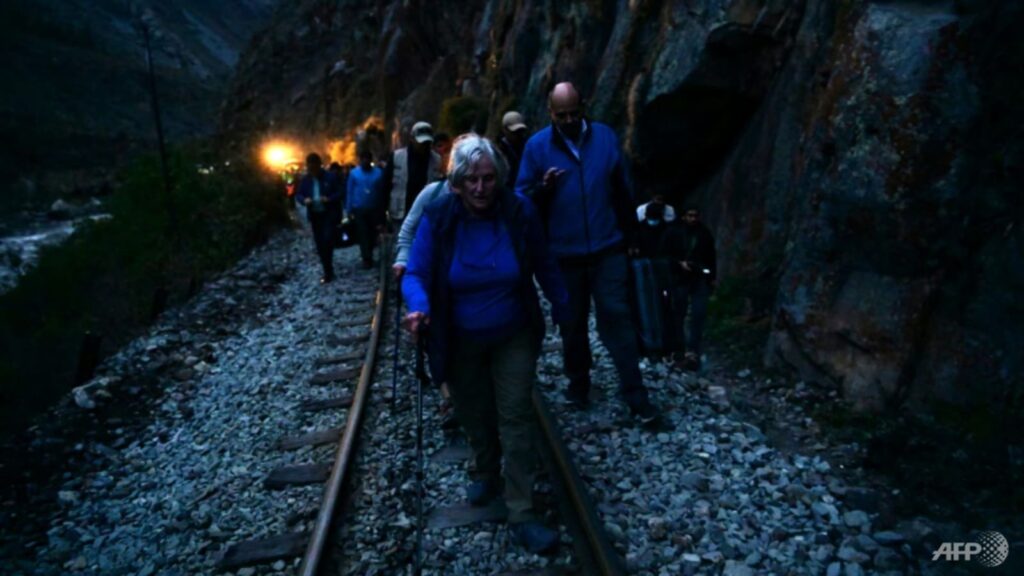PISCACUCHO: “Machu Picchu was great, but we will remember longer the days of stress that followed. Unforgettable,” laughed Alex Lim, a 41-year-old Canadian among 200 tourists evacuated on Saturday (Dec 17) from the Inca citadel due to unrest in Peru.
Lim and his wife Kate were among 500 mostly foreign but also Peruvian tourists stranded on Tuesday at the foot of the World Heritage Site in the small town of Aguas Calientes after the train line was blocked by demonstrators protesting the ouster and imprisonment of former president Pedro Castillo.
As the railway is the only way in or out of Aguas Calientes, the tourists found themselves stuck for five days in the village’s hotel rooms without their belongings, as most had been staying in the Inca imperial city of Cusco, located 110km away.
“I feel better now,” said Lim. “We were kind of worried. I didn’t have my medication for hypertension at the beginning. We only had clothes for one day.”
He was finally able to obtain some medicine after a visit from a doctor sent by the authorities.
The couple who had started a “great post-COVD trip” had not yet decided whether to continue with their adventure or return home to Toronto.
“We are going to rest, de-stress and then we will decide,” said Alex, who stressed that, despite the protests, the Peruvians had been “welcoming”.
“RELIEVED TO GET OUT”
On Saturday “with the support of the police and the armed forces”, authorities were able to send equipment and men to repair and clear the 29km track between Piscacucho and Aguas Calientes, said tourism minister Luis Fernando Helguero, who was at the site to monitor operations.
Piscacucho, one of the starting points of the Inca Trail trek to Machu Picchu, is the nearest hamlet reachable by road from Aguas Calientes.
“We found out by chance that there was this train that was leaving Machu Picchu, and I and another friend managed to board 10 minutes before the train left,” said Brazilian Guilherme Bucco, a professor at the University of Porto Alegre.
“Aguas Calientes is very pretty, but after an hour you have nothing more to do! So five days … I had to cancel a lot of plans and I have to work again next week,” he said.
“But I’m relieved to get out of there.”
Another unpleasant surprise awaited the travellers.
While the railway workers did their best to repair the track, they could not remove a huge boulder that was thrown from the cliffs by demonstrators.
As a result, the tourists had to walk about 2km after dark along the railway line by the light of mobile phones to join the minivans waiting to transport them back to Cusco.
While police and railway workers helped to carry their bags, the steep journey was not easy, especially for the older tourists.
“They were hoping to get us out by helicopter but because of the weather they could not do that,” said American Avis Berney, 77, from Whidbey Island, near Seattle.
“The rock was as big as a car, a small Renault!” she said.
“My stick saved me! I’m retired and tired,” she joked.
After the headache of the evacuation, the tourism minister was hoping that the protests which have left at least 19 dead would subside so that “tourism can resume”.
Tourism represents 3 per cent to 4 per cent of Peru’s gross domestic product and provides employment “to all strata of the economy”, Helguero said.
“We have calculated a loss of 200 million soles (US$52 million),” in the sector due to the protests, he said.
The minister was worried about the damage to Peru’s image in the eyes of tour operators and tourists.
The country’s tourism industry has struggled to recover after COVID-19, attracting 2 million visitors in 2022, far short of the 4.4 million arrivals in 2019.
“The problem is not the damage of a week, the problem is to regain the level of tourism that we had in 2019 and to exceed it to reach 5 million,” Helguero said.
On Friday, Singapore’s Ministry of Foreign Affairs (MFA) advised Singaporeans to defer all non-essential travel to Peru.
“A 30-day nationwide state of emergency was declared in Peru on Dec 14, 2022, due to ongoing protests. Currently, the most affected regions are in Arequipa, Cusco and Puno, but the situation is fast evolving,” MFA sad.
“Singaporeans are advised to defer all non-essential travel to Peru.”
Singaporeans residing in Peru, or who are still planning on travelling there, should take all necessary precautions for their personal safety, MFA added.
“They are advised to avoid areas where demonstrations and large gatherings are taking place, monitor the local news closely and heed the instructions of local authorities,” the ministry said.
“Travellers should purchase comprehensive travel and medical insurance and are encouraged to e-register with MFA at https://eregister.mfa.gov.sg.”
